Somatic therapy, also referred to as somatic experiencing therapy, is a type of therapy that is centered around the connection between the mind and body.
Psychotherapy and physical therapy are both used in somatic therapy to help heal a variety of different ailments and conditions, including:
Somatic therapy uses mind-body techniques to help release stress, trauma, and tension that has become “locked away” in the body. By learning to self-regulate, patients are able to focus on healing trauma with the help of a mental health professional.
There are many different types of somatic therapy that have been used for centuries.
One of the main schools of somatics was created by Thomas Hannah in the 1970s, who named the concept of “somatics.”
Not long after, Dr. Peter Levine developed somatic experiences partly from observing how animals recover from repeated traumatic experiences.
Throughout the 1970s, 80s, and 90s, different kinds of somatic therapy interventions emerged and are still used today and integrated into modern forms.
But, what all of them have in common is the belief that the body is connected to the mind and can help heal a person facing challenges with their mental health, which proved to be a more holistic approach than traditional talk therapy.
The 19th century was a time when many physical education movements arose, like yoga, pilates, and judo.
“Somatics” came about in the 1970s when Thomas Hanna theorized that much of chronic pain comes from the loss of the ability of neurons in the brain to control muscle tissue.
With this idea, a person can find relief through education, mindfulness, and intentional movement.
In the 1970s, Dr. Peter Levine developed somatic experiencing, which partly came from Jungian therapy.
The idea was that when humans experience trauma, they can get stuck in the “freeze” mode of the fight, flight, or freeze response. Remaining “frozen” causes the negative energy to stay in the body, which can lead to physical and mental problems.
Additionally, the Hakomi method was also developed in the 1970s by Ron Kurtz. It is centered around the practice of mindfulness and focuses on how we live in our bodies in order to promote wellness.
In the 1980s and 1990s, sensorimotor therapy was created with help from Pat Ogden. Sensorimotor therapy integrates ideas from both cognitive behavioral therapy and neuroscience.
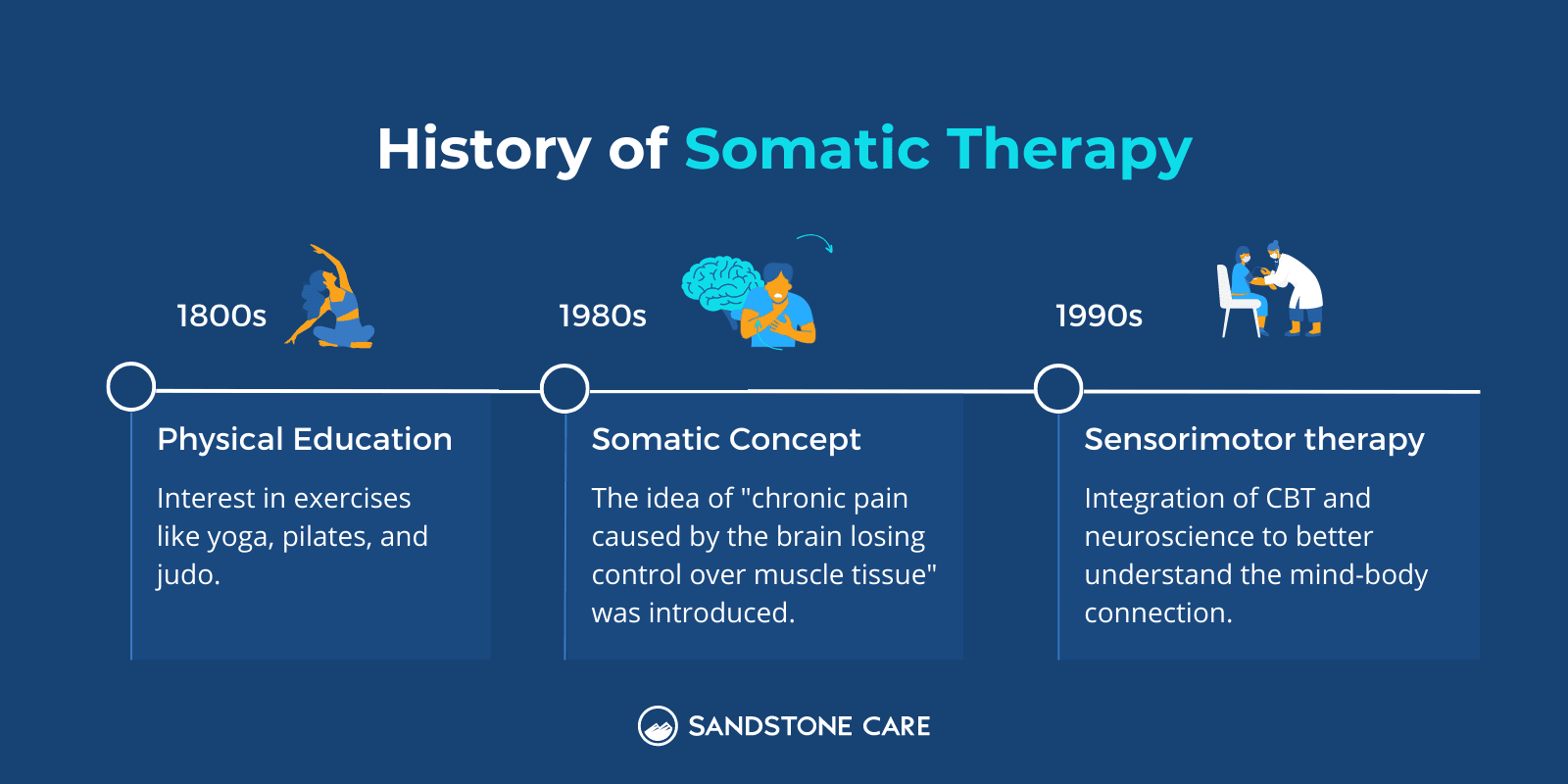
Generally speaking, “somatics” refers to body movement as a way to improve mental health.
The idea is that people can find healing for both chronic pain and mental health conditions through intentional movements that connect their mind-body pathways.
Somatics is used to find healing and relief for stress, pain, trauma, and much more.
Somatic experiencing can be especially beneficial for individuals who have experienced trauma and great amounts of stress in finding relief and healing.
It provides a different way to understand trauma and process it.
In releasing locked-away emotions and stress, a person can improve their physical and emotional health and well-being.
The theory of somatic therapy is based on the idea that the things that happen in a person’s life, including negative experiences, are not only stored in the brain but in the body as well.
According to this theory, a person can find healing through therapy that addresses the mind and body connection.
The mind-body connection, or the somatic connection, refers to the way your thoughts are connected to your feelings.
“Feelings” imply a physical sensation that is felt in the body.
The way a person thinks impacts the way they feel, and vice versa.
So, with this idea, when a person is experiencing negative thoughts, it will impact their mind and their body as well.
This idea that the mind and body are connected opens up a pathway to healing that can be used for trauma, stress, anxiety, addiction, and other mental health disorders.
The main goal of somatic therapy is to help a person increase awareness of the physical sensations that come from their mental health conditions and use this awareness to release tension, stress, and trauma and find healing.
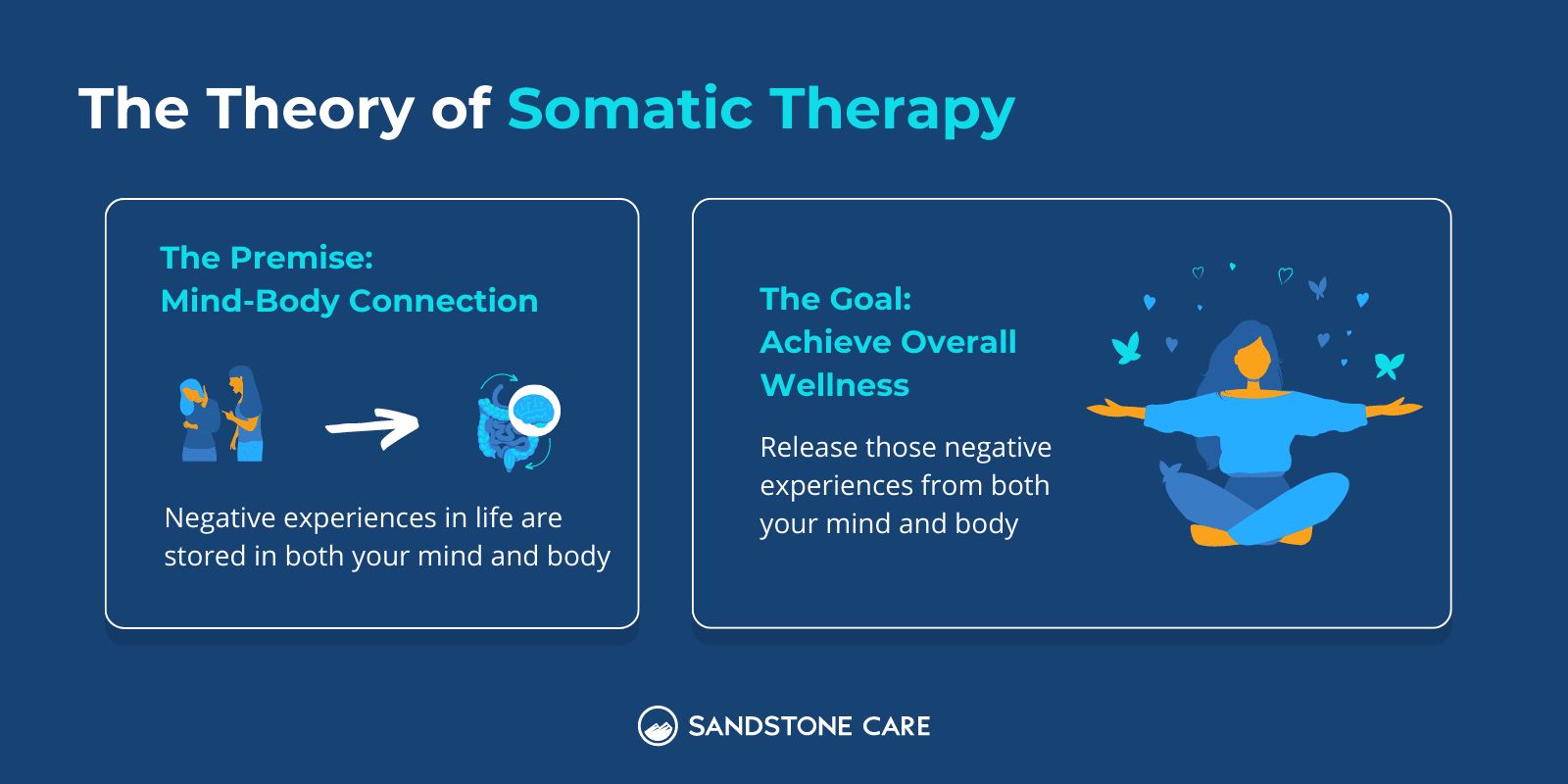
Each somatic therapy session looks different based on the individual.
In somatic therapy, a therapist will use different mind-body techniques that help a person release tension, stress, trauma, and negativity that has been locked away.
A therapist may use techniques like breathing exercises, postures, gestures, and other forms of movement to help release these feelings.
The frequency and length of time for somatic therapy depend entirely on the individual and their needs.
Some people find it helpful to go weekly, while others may prefer to space out their sessions for a few weeks.
Many people feel differences immediately after their first session.
For others, it may take a few days or weeks, but it varies based on each individual.
It can be hard to know what to expect as each individual experience is unique.
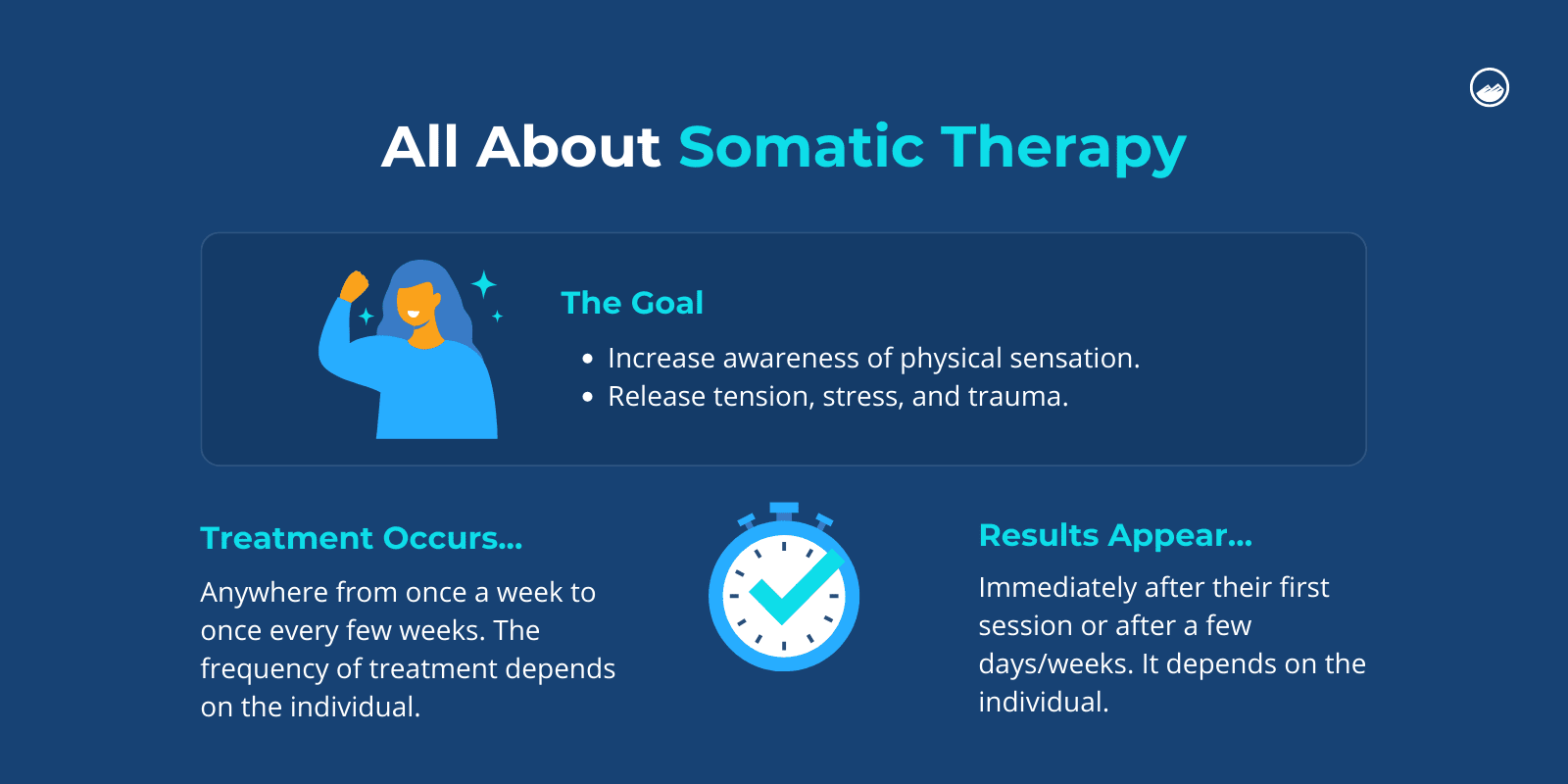
The body has an amazing ability to heal itself, both physically and mentally.
When a person goes through a stressful or traumatic experience, the body goes into survival mode because it is faced with danger.
The body works to protect you and is constantly in communication with the brain to try to maintain a balanced state.
Somatic healing works by helping an individual identify and acknowledge the bodily sensations that are connected with difficult feelings or traumatic events.
After one has learned more about the trauma response and how it works, the therapist will work with them to find calmness and help them learn how to be in the present moment as they work through their experiences.
Gradually, a person will start to revisit their experiences while the therapist follows the bodily sensations that arise.
Throughout therapy, a person can find healing through the release of these physical sensations and energy that is trapped in the body.
The therapist will guide the individual through a variety of different techniques to help the person process and release the trauma.
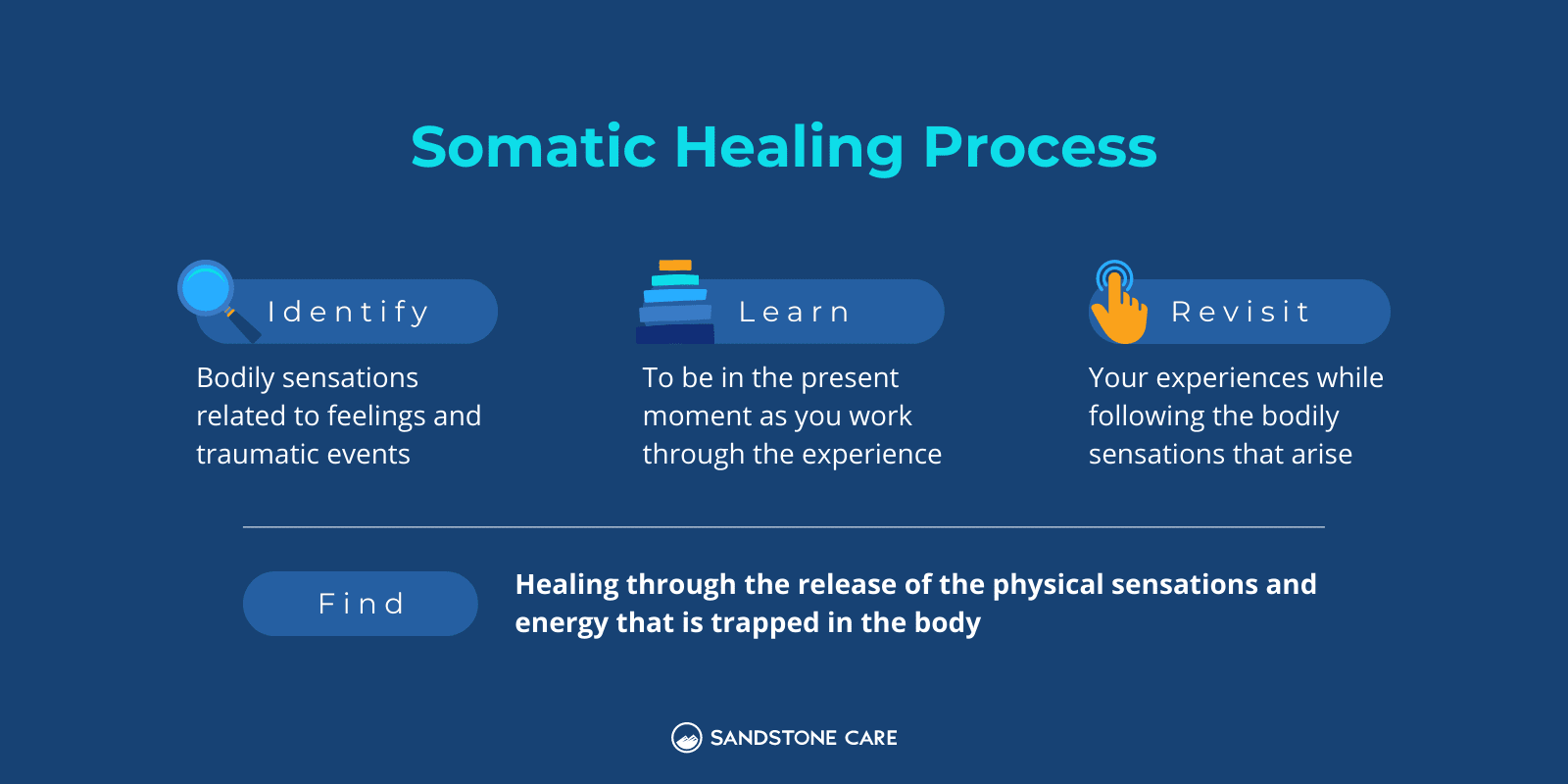
Some of the most common forms of somatic therapy include:
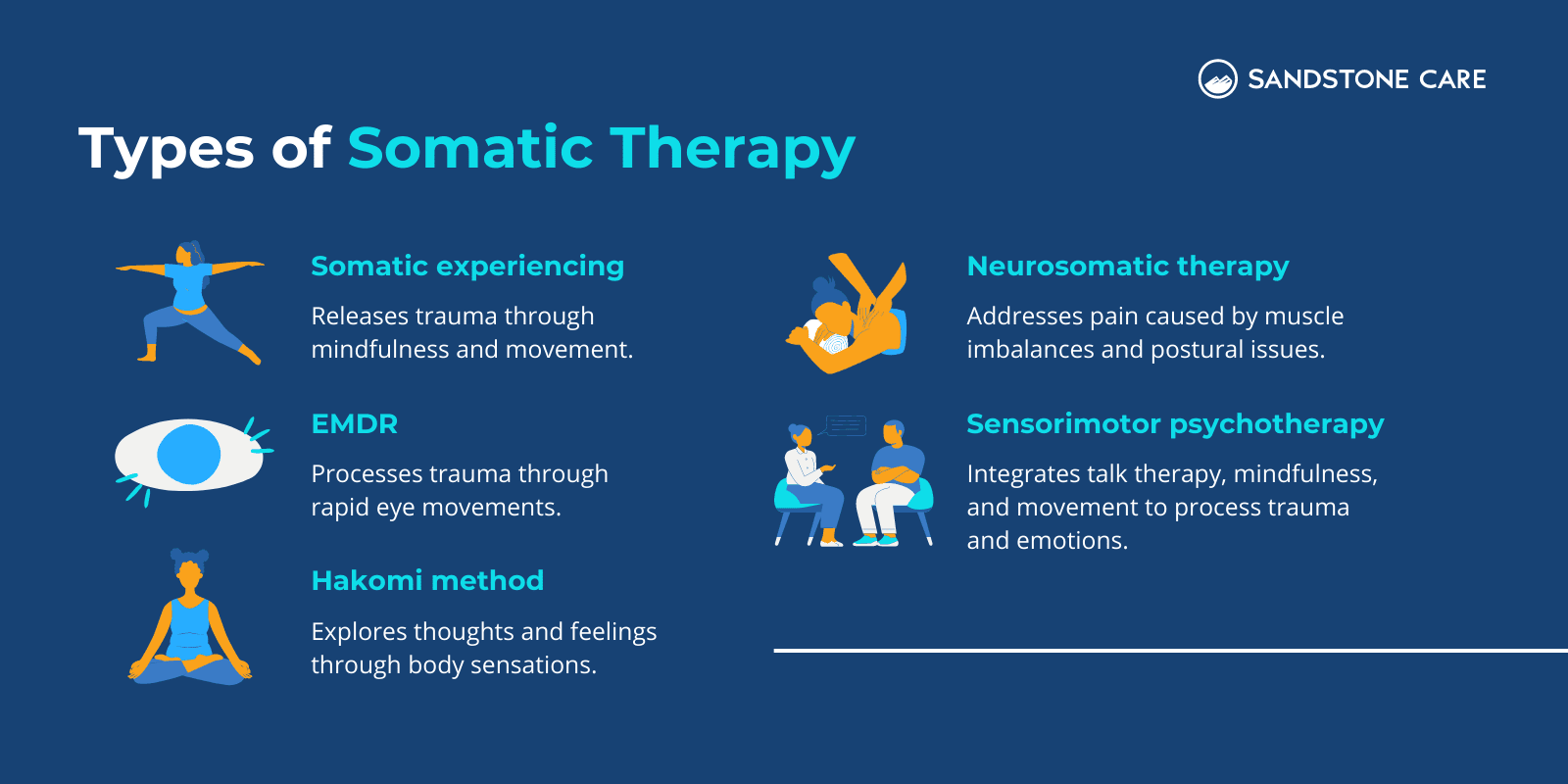
Yoga is a common example of somatic practice.
With yoga, a person uses the mind-body connection to build awareness and find healing.
Somatic activities involve movement that helps a person bring awareness to the connection between their mind and body.
Some common mind-body exercises can include:
Research shows that exposure to trauma leads to a number of different changes in biology and stress response.
When someone experiences trauma, it can alter brain chemistry and the way the brain functions.
The “fight-or-flight” response is a physiological response to a potentially harmful or stressful event.
However, research shows that there is a third response called the “freeze response,” which can happen both in the brain and physically.
This can affect key functions like decision-making, remembering important information, planning responses, etc.
Somatic therapy can help a person relieve emotional and bodily stress that is “trapped” in the nervous system through intentional movement.
The polyvagal theory suggests that the mammalian autonomic nervous system has evolved to adopt behavioral strategies like staying safe and surviving.
Somatic therapy can integrate the polyvagal theory into somatic experiences and practices to help release trauma both emotionally and physically.
Polyvagal-informed somatic therapy can help a person work with their nervous system rather than fight against it in a safe and healthy way.
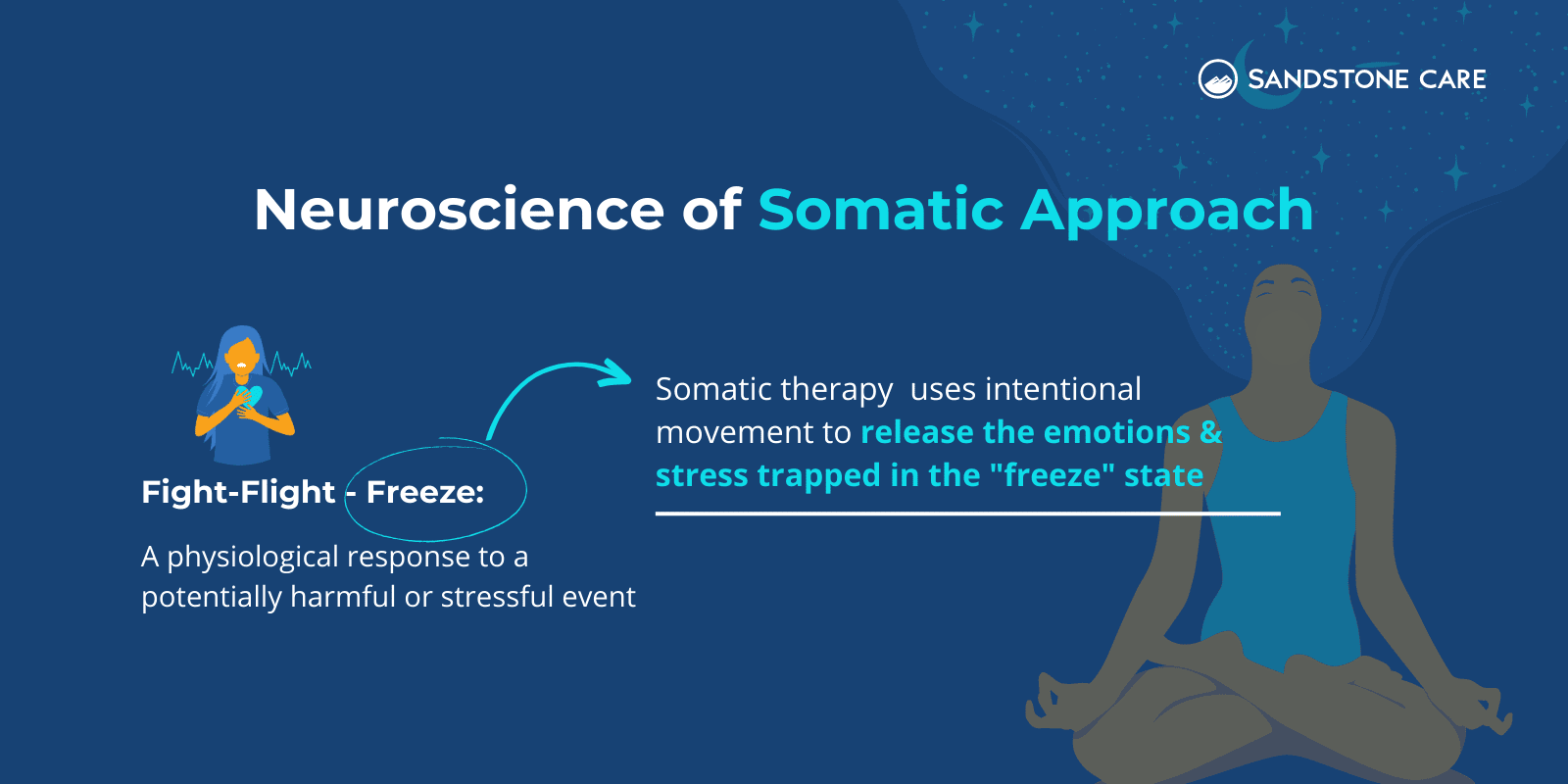
Somatic therapy sessions are unique to each individual but involve both talk therapy and some form of physical therapy.
Therapy sessions often involve techniques that include:
Some examples of somatic therapy techniques include:
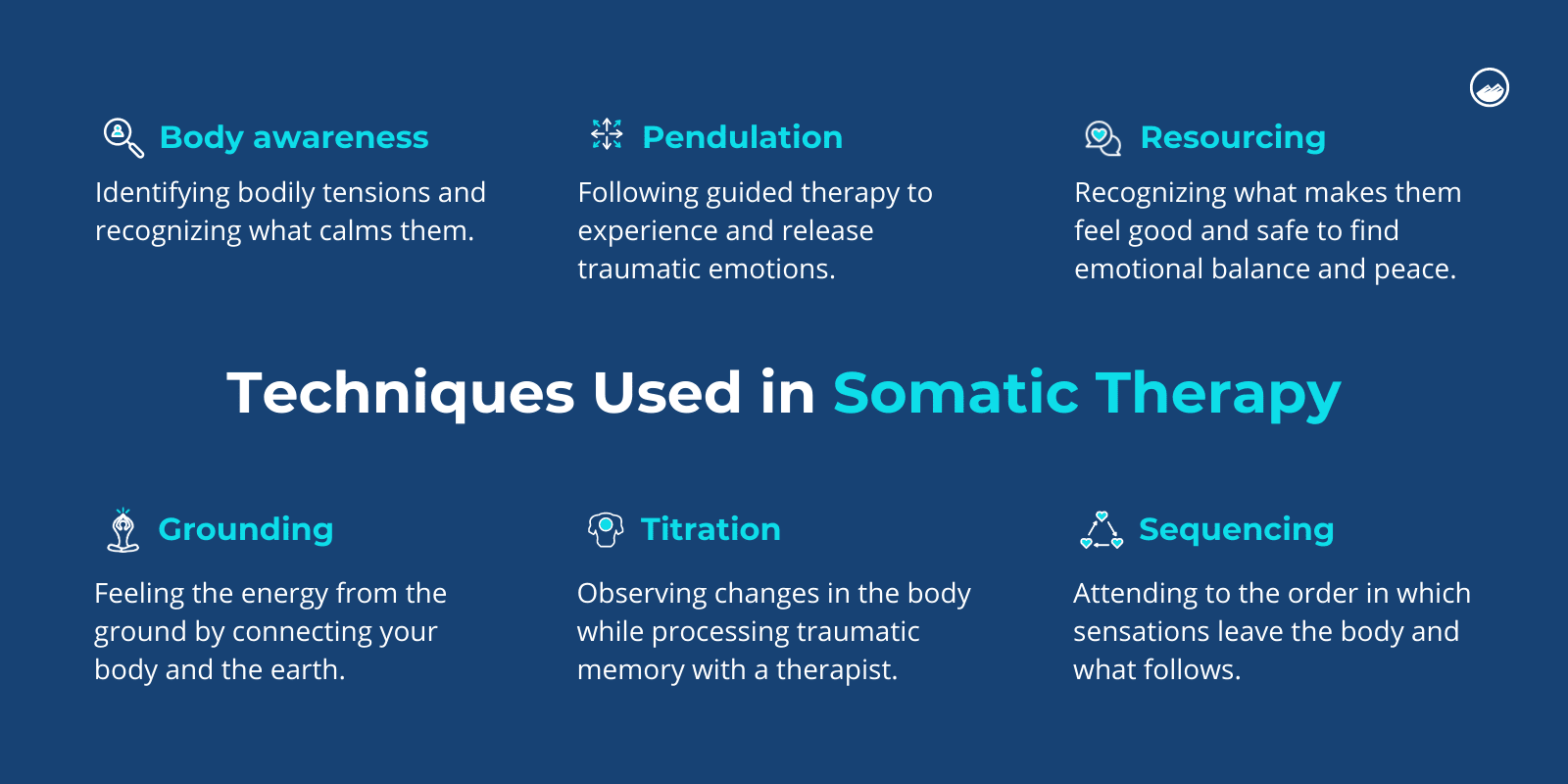
Somatic therapy can benefit individuals who have experienced trauma and Post-traumatic stress disorder (PTSD).
Other benefits of somatic therapy include:
Somatic therapy can be beneficial for many different people.
It can help individuals who have experienced trauma, people with anxiety and depression, those with chronic pain or illness, athletes, performers, and others who may have locked away stress and emotions.

Somatic release works by using mind-body techniques to release stress and trauma that is affecting one’s physical and mental health.
The idea is that after a traumatic or stressful experience, a person’s nervous system can get stuck in “freeze” mode.
With somatic experiencing, rather than just recalling these experiences, a person feels the physical symptoms that present when they think of them and engages in intentional body movement to help process and release the stress and tension that has been locked away.
According to the Harvard Review of Psychiatry, research has shown that trauma is stored in somatic memory and is shown as changes in the biological stress response.
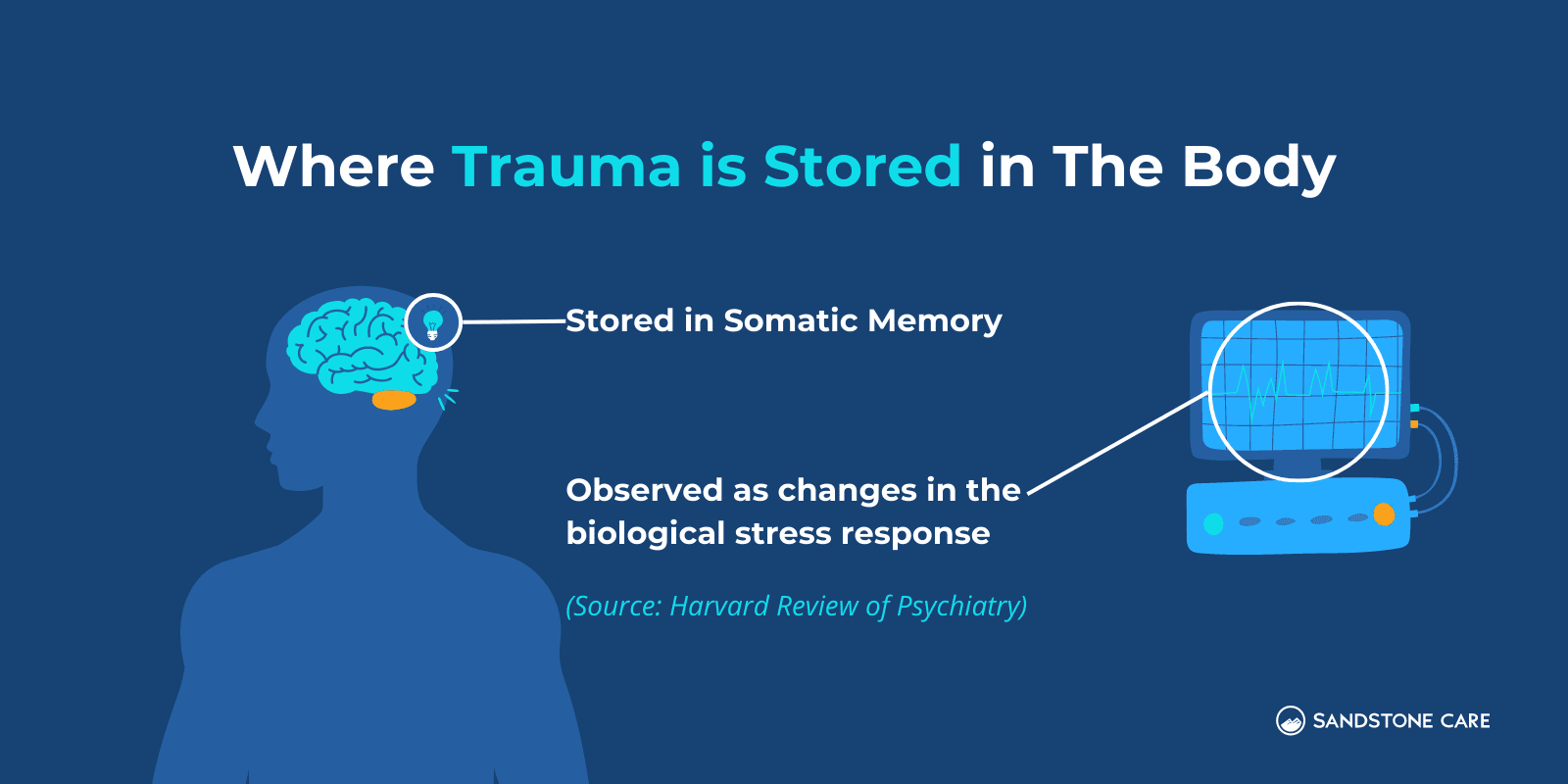
There are different ways that people release trapped emotions from the body.
One step in releasing trapped emotions is identifying and acknowledging what feelings and emotions are there.
Then, it is important to find ways to work through these past traumas, usually with the help of a therapist.
Somatic therapy focuses on intentional movement to release these trapped emotions from the body.
Outside of therapy, it can be helpful to spend time alone, practicing stillness and mindfulness, go outdoors, listen to music, and practice meaningful physical activities.
Releasing stress and trauma can present in physical signs and symptoms that include:
When the body releases trauma, a person may feel freer, lighter, and happier.
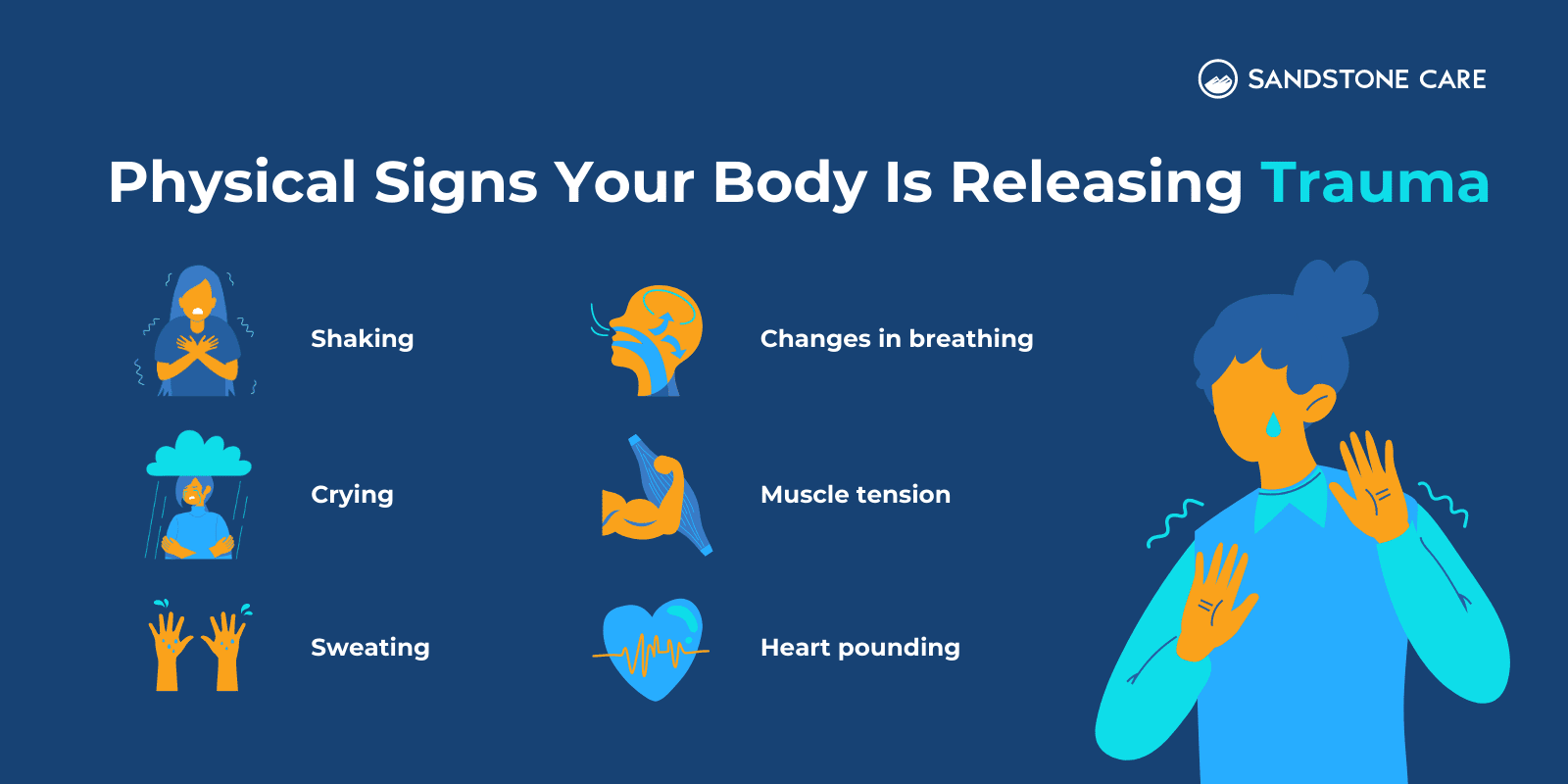
It is important that you find a therapist that you feel comfortable with.
Sometimes, it can feel stressful and overwhelming trying to choose the right therapist for you.
Doing research and asking questions is a great way to find the best fit.
There is no specific accreditation for somatic therapy, but it is good to find a therapist with experience in treating individuals who may share similar experiences with you.
Some questions you can ask when it comes to choosing a potential therapist include:

Before a somatic therapy session, there are ways to mentally and physically prepare yourself before you go in.
It can be helpful to make sure you set aside alone time before your session to find calmness, gather your thoughts, and possibly set some personal goals for your session.
Another important thing to do before a therapy session is to make sure you give yourself credit for taking steps to heal.
Going to therapy can be difficult and overwhelming, and it is important to recognize how proud you should be of yourself.
FAQ
Our goal is to provide the most helpful information. Please reach out to us if you have any additional questions. We are here to help in any way we can.
Somatic therapy should be done with a therapist, but there are some somatic experiencing exercises you can do on your own.
Doing things like breathing exercises, relaxation, and meditation can help a person find some relief throughout their everyday life, along with seeing a somatic therapist.
EMDR is a form of somatic therapy.
Eye movement desensitization and reprocessing (EMDR) is a type of therapy that was originally used to relieve stress that is associated with traumatic memories.
In EMDR therapy, the therapist will help the individual recall traumatic memories while also focusing on an external stimulus.
This can help a person process information, learn new ways to cope, and relieve some emotional distress.
Both somatic therapy and EMDR are used to treat mental health conditions like anxiety, depression, and PTSD.
EMDR and somatic therapy are not the same, but they are both relatively new traditional therapy alternatives.
Somatic therapy has been shown to be a possible effective therapy for PTSD, according to the Journal of Traumatic Stress.
Some somatic therapies are evidence-based, meaning that it has been through evaluations and tests for efficacy.
Psychotherapy, also referred to as talk therapy, is a variety of treatments used to help individuals with stress, mental health, and substance use disorders.
It is used to help a person identify and change unhealthy thoughts, emotions, and behaviors.
When comparing psychotherapy and somatic therapy, psychotherapy mainly focuses on the mind, whereas somatic therapy focuses on both the mind and body.


Somatic therapy focuses on the mind-body connection and can be helpful for individuals who have experienced stress, trauma, and challenges with their mental health. Sandstone Care is here to support teens and young adults with mental health and substance use disorders.